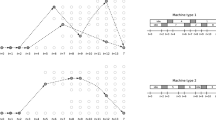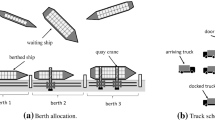Abstract
The plethora of research on \(\mathcal {NP}\)-hard parallel machine scheduling problems is focused on heuristics due to the theoretically and practically challenging nature of these problems. Only a handful of exact approaches are available in the literature, and most of these suffer from scalability issues. Moreover, the majority of the papers on the subject are restricted to the identical parallel machine scheduling environment. In this context, the main contribution of this work is to recognize and prove that a particular preemptive relaxation for the problem of minimizing the total weighted completion time (TWCT) on a set of unrelated parallel machines naturally admits a non-preemptive optimal solution and gives rise to an exact mixed integer linear programming formulation of the problem. Furthermore, we exploit the structural properties of TWCT and attain a very fast and scalable exact Benders decomposition-based algorithm for solving this formulation. Computationally, our approach holds great promise and may even be embedded into iterative algorithms for more complex shop scheduling problems as instances with up to 1000 jobs and 8 machines are solved to optimality within a few seconds.


Similar content being viewed by others
References
Azizoglu, M., & Kirca, O. (1999a). On the minimization of total weighted flow time with identical and uniform parallel machines. European Journal of Operational Research, 113(1), 91–100.
Azizoglu, M., & Kirca, O. (1999b). Scheduling jobs on unrelated parallel machines to minimize regular total cost functions. IIE Transactions, 31(2), 153–159.
Barnes, J. W., & Brennan, J. (1977). An improved algorithm for scheduling jobs on identical machines. AIIE Transactions, 9(1), 25–31.
Belouadah, H., & Potts, C. N. (1994). Scheduling identical parallel machines to minimize total weighted completion time. Discrete Applied Mathematics, 48(3), 201–218.
Benders, J. F. (1962). Partitioning procedures for solving mixed-variables programming problems. Numerische Mathematik, 4(1), 238–252.
Biskup, D., Herrmann, J., & Gupta, J. N. (2008). Scheduling identical parallel machines to minimize total tardiness. International Journal of Production Economics, 115(1), 134–142.
Blazewicz, J., Ecker, K. H., Pesch, E., Schmidt, G., & Weglarz, J. (2007). Handbook on scheduling: from theory to applications. New York: Springer.
Bruno, J., Coffman, E. G, Jr., & Sethi, R. (1974). Scheduling independent tasks to reduce mean finishing time. Communications of the ACM, 17(7), 382–387.
Bülbül, K., Kaminsky, P., & Yano, C. (2007). Preemption in single machine earliness/tardiness scheduling. Journal of Scheduling, 10(4–5), 271–292.
Burkard, R., Dell’Amico, M., & Martello, S. (2009). Assignment problems. Philadelphia: Society for Industrial and Applied Mathematics.
Chekuri, C., & Khanna, S. (2004). Approximation algorithms for minimizing average weighted completion time. In J. Y. Leung (Ed.), Handbook of scheduling: algorithms, models, and performance analysis. Boca Raton: CRC Press.
Chen, Z.-L., & Powell, W. B. (1999). Solving parallel machine scheduling problems by column generation. INFORMS Journal on Computing, 11(1), 78–94.
Cheng, T., & Sin, C. (1990). A state-of-the-art review of parallel-machine scheduling research. European Journal of Operational Research, 47(3), 271–292.
Detienne, B., Dauzère-Pérès, S., & Yugma, C. (2011). Scheduling jobs on parallel machines to minimize a regular step total cost function. Journal of Scheduling, 14, 523–538.
Dyer, M., & Wolsey, L. (1990). Formulating the single machine sequencing problem with release dates as a mixed integer program. Discrete Applied Mathematics, 26(2–3), 255–270.
Elmaghraby, S. E., & Park, S. H. (1974). Scheduling jobs on a number of identical machines. AIIE Transactions, 6(1), 1–13.
Fischetti, M., Salvagnin, D., & Zanette, A. (2010). A note on the selection of Benders’ cuts. Mathematical Programming, 124(1–2), 175–182.
Goemans, M. X., Queyranne, M., Schulz, A. S., Skutella, M., & Wang, Y. (2002). Single machine scheduling with release dates. SIAM Journal on Discrete Mathematics, 15(2), 165–192.
Graham, R., Lawler, E., Lenstra, J., Rinnooy Kan, A., & Hammer, P. L. (1979). Optimization and approximation in deterministic sequencing and scheduling: a survey. In P. L. Hammer & B. Korte (Eds.), Discrete optimization II (Vol. 5, pp. 287–326)., Annals of discrete mathematics New York: Elsevier.
IBM ILOG CPLEX (2012). IBM ILOG CPLEX Optimization Studio 12.5 Information Center. Retrieved 08 April 2014 from http://pic.dhe.ibm.com/infocenter/cosinfoc/v12r5/index.jsp.
Kedad-Sidhoum, S., Solis, Y. R., & Sourd, F. (2008). Lower bounds for the earliness-tardiness scheduling problem on parallel machines with distinct due dates. European Journal of Operational Research, 189(3), 1305–1316.
Lawler, E. L., & Moore, J. M. (1969). A functional equation and its application to resource allocation and sequencing problems. Management Science, 16(1), 77–84.
Lee, C.-Y., & Uzsoy, R. (1992). A new dynamic programming algorithm for the parallel machines total weighted completion time problem. Operations Research Letters, 11(2), 73–75.
Li, K., & Yang, S.-L. (2009). Non-identical parallel-machine scheduling research with minimizing total weighted completion times: Models, relaxations and algorithms. Applied Mathematical Modelling, 33(4), 2145–2158.
Lin, Y., Pfund, M., & Fowler, J. (2011). Heuristics for minimizing regular performance measures in unrelated parallel machine scheduling problems. Computers and Operations Research, 38(6), 901–916.
Magnanti, T. L., & Wong, R. T. (1981). Accelerating Benders decomposition: Algorithmic enhancement and model selection criteria. Operations Research, 29(3), 464–484.
Mokotoff, E. (2001). Parallel machine scheduling problems: A survey. Asia Pacific Journal of Operational Research, 18(2), 193–242.
Nessah, R., Yalaoui, F., & Chu, C. (2008). A branch-and-bound algorithm to minimize total weighted completion time on identical parallel machines with job release dates. Computers & Operations Research, 35(4), 1176–1190.
Pan, Y., & Shi, L. (2007). On the equivalence of the max-min transportation lower bound and the time-indexed lower bound for single-machine scheduling problems. Mathematical Programming, 110(3), 543–559.
Pinedo, M. (2008). Scheduling: theory, algorithms, and systems (3rd ed.). New York: Springer.
Plateau, M.-C., & Rios-Solis, Y. A. (2010). Optimal solutions for unrelated parallel machines scheduling problems using convex quadratic reformulations. European Journal of Operational Research, 201(3), 729–736.
Posner, M. E. (1985). Minimizing weighted completion times with deadlines. Operations Research, 33(3), 562–574.
Rodriguez, F., Blum, C., García-Martínez, C., & Lozano, M. (2012). GRASP with path-relinking for the non-identical parallel machine scheduling problem with minimising total weighted completion times. Annals of Operations Research, 201(1), 383–401.
Rodriguez, F. J., Lozano, M., Blum, C., & García-Martínez, C. (2013). An iterated greedy algorithm for the large-scale unrelated parallel machines scheduling problem. Computers & Operations Research, 40(7), 1829–1841.
Rubin, P. (2011). Benders decomposition then and now. Retrieved 24 April 2013 from http://orinanobworld.blogspot.com/2011/10/benders-decomposition-then-and-now.html.
Sarin, S. C., Ahn, S., & Bishop, A. B. (1988). An improved branching scheme for the branch and bound procedure of scheduling n jobs on m parallel machines to minimize total weighted flowtime. International Journal of Production Research, 26(7), 1183–1191.
Şen, H. & Bülbül, K. (2012). A simple, fast, and effective heuristic for the single-machine total weighted tardiness problem. In E. Demeulemeester & W. Herroelen (Eds.) Proceedings of the 13th International Conference on Project and Scheduling (PMS 2012), pp. 282–286, Leuven: Belgium.
Şen, H., & Bülbül, K. (2015). A strong preemptive relaxation for weighted tardiness and earliness/tardiness problems on unrelated parallel machines. INFORMS Journal on Computing, 27(1), 135–150.
Shim, S.-O., & Kim, Y.-D. (2007). Minimizing total tardiness in an unrelated parallel-machine scheduling problem. Journal of the Operational Research Society, 58(3), 346–354.
Skutella, M. (2001). Convex quadratic and semidefinite programming relaxations in scheduling. Journal of the ACM (JACM), 48(2), 206–242.
Smith, W. E. (1956). Various optimizers for single-stage production. Naval Research Logistics Quarterly, 3(1–2), 59–66.
Sourd, F., & Kedad-Sidhoum, S. (2003). The one-machine problem with earliness and tardiness penalties. Journal of Scheduling, 6(6), 533–549.
Unlu, Y., & Mason, S. J. (2010). Evaluation of mixed integer programming formulations for non-preemptive parallel machine scheduling problems. Computers & Industrial Engineering, 58(4), 785–800.
van den Akker, J. M., Hoogeveen, J. A., & van de Velde, S. L. (1999). Parallel machine scheduling by column generation. Operations Research, 47(6), 862–872.
Vredeveld, T., & Hurkens, C. (2002). Experimental comparison of approximation algorithms for scheduling unrelated parallel machines. INFORMS Journal on Computing, 14(2), 175–189.
Yalaoui, F., & Chu, C. (2006). New exact method to solve the \({P}m/r_j/\sum _j {C}_j\) schedule problem. International Journal of Production Economics, 100(1), 168–179.
Author information
Authors and Affiliations
Corresponding author
Appendices
Appendix: Proof of Proposition 3.1
Proof
The proof consists of two main steps. First, we show that \((\overline{\varvec{u}}{}_k,\overline{\varvec{v}}{}_k)\) is a feasible solution for \(\left( \mathbf {DS_{\varvec{k}}-R}\right) \), i.e., \(\overline{v}{}_{kt} \le {} 0\) for all \(t=1,\ldots {},H_k\) and \(\overline{u}{}_{jk} + \overline{v}{}_{kt} \le {} c_{jkt}\) for all \(j\in {}J_k\) and \(t=1,\ldots {},H_k\). Then, we demonstrate that the objective function value associated with this feasible solution of the dual slave problem is equal to that of the optimal solution of the corresponding primal problem. Our focus in this proof is entirely on \(\left( \mathbf {DS_{\varvec{k}}-R}\right) {}\) for a given machine k, and therefore, every specific job or set of jobs referred to in the following belongs to \(J_k\).
The non-positivity of \(\overline{v}{}_{kt}\) for all \(t=1,\ldots {},H_k\) follows from
where
and the weights and the processing times are strictly positive.
To show that \(\overline{u}{}_{jk} + \overline{v}{}_{kt} \le {} c_{jkt}\) is satisfied for all \(j\in {}J_k\) and \(t=1,\ldots {},H_k\), we substitute the values of \(\overline{u}_{jk}\) and \(\overline{v}_{kt}\) from (27) and \(c_{jkt}\) from (10). The constraint \(\overline{u}{}_{jk} + \overline{v}{}_{kt} \le {} c_{jkt}\) then reduces to
by replacing \(t - \sum _{i\le l(t){}} p_{ik}\) by \(-r(t){}\) and t by \(\sum _{i\le {}l(t){}} p_{ik} - r(t){}\) based on (30). In order to establish the validity of (31), we consider the cases \(j \le {} l(t){}\) and \(j > l(t){}\) separately.
If \(j \le {} l(t){}\), (31) simplifies to
Note that \(j \le {} l(t){}\) implies \(\frac{w_j}{p_{jk}} \ge \frac{w_{l(t){}}}{p_{l(t){}k}}\) and leads to \( \left( p_{l(t){}k} - 1\right) \left( \frac{w_{l(t){}}}{p_{l(t){}k}} - \frac{w_j}{p_{jk}} \right) \le {} r(t){} \left( \frac{w_{l(t){}}}{p_{l(t){}k}} - \frac{w_j}{p_{jk}} \right) \) based on (30). Therefore, (32) holds if
is satisfied, where the transition from (33) to (34) requires adding \(p_{l(t){}k}\frac{w_j}{p_{jk}}-w_{l(t){}}\) to both sides of (33). The inequality (34) is clearly correct since \(\left( \frac{w_i}{p_{ik}} - \frac{w_j}{p_{jk}} \right) \le {} 0 \) for \(i \ge {} j\) and \(\left( \frac{w_j}{p_{jk}} - \frac{w_{l(t){}}}{p_{l(t){}k}} \right) \ge {} 0\), and this completes the argument for the first case with \(j \le {} l(t){}\).
If \(j > l(t){}\), re-arranging the terms of (31) leads to
The inequality \(\frac{w_j}{p_{jk}} \le \frac{w_{l(t){}}}{p_{l(t){}k}}\) follows from \(j > l(t){}\), and we conclude that the right hand side of (35) is non-negative. Therefore, in order to prove that (35) is satisfied it is sufficient to demonstrate the correctness of this relation:
The validity of inequality (36) derives from \( \left( \frac{w_j}{p_{jk}} - \frac{w_i}{p_{ik}} \right) \le {} 0 \) for \(i \le {} j\). This yields the correctness of (31) for the second case with \(j > l(t){}\), and \((\overline{\varvec{u}}{}_k,\overline{\varvec{v}}{}_k)\) is certified as a feasible solution of \(\left( \mathbf {DS_{\varvec{k}}-R}\right) \).
As noted before, the optimal schedule of the restricted cut generation subproblem \(\left( \mathbf {TR_{\varvec{k}}-R}\right) \)—the primal problem associated with \(\left( \mathbf {DS_{\varvec{k}}-R}\right) \)—follows the WSPT order for the jobs in \(J_k\). Therefore, the associated optimal objective function value is calculated as \(\sum _{j\in {}J_k} w_j \left( \sum _{i\le {}j} p_{ik} \right) \), where the completion time of job j in the non-preemptive WSPT schedule is equal to the sum of the processing times of the jobs placed earlier in the WSPT sequence. Thus, in order to complete the proof, we must argue that the objective function value associated with \((\overline{\varvec{u}}{}_k,\overline{\varvec{v}}{}_k)\) in \(\left( \mathbf {DS_{\varvec{k}}-R}\right) \) is equal to \(\sum _{j\in {}J_k} w_j \left( \sum _{i\le {}j} p_{ik} \right) \).
For the transition from (37) to (38), observe that each job \(j\in J_k\) becomes the job \(l(t){}\) for \(p_{jk}\) consecutive time periods, and the difference \(\left( t - \sum _{i\le {}l(t){}} p_{ik} \right) \) runs from \(-(p_{jk}-1)\) to zero during these time periods. Therefore, we have \(\sum _{t=1}^{H_k} \frac{w_{l(t){}}}{p_{l(t){}k}}\left( t - \sum _{i\le {}l(t){}} p_{ik} \right) =\sum _{j\in {}J_k} \frac{w_j}{p_{jk}}\left( -\sum _{i=0}^{p_{jk}-1} i \right) \). A similar argument yields \(-\sum _{t=1}^{H_k} \sum _{i>l(t){}} w_i =-\sum _{j\in {}J_k} p_{jk}\sum _{i>j}w_i\).
Benders decomposition algorithm with cut strengthening for \(\left( \mathbf {TR-A}\right) \)



Rights and permissions
About this article
Cite this article
Bülbül, K., Şen, H. An exact extended formulation for the unrelated parallel machine total weighted completion time problem. J Sched 20, 373–389 (2017). https://doi.org/10.1007/s10951-016-0485-x
Published:
Issue Date:
DOI: https://doi.org/10.1007/s10951-016-0485-x




